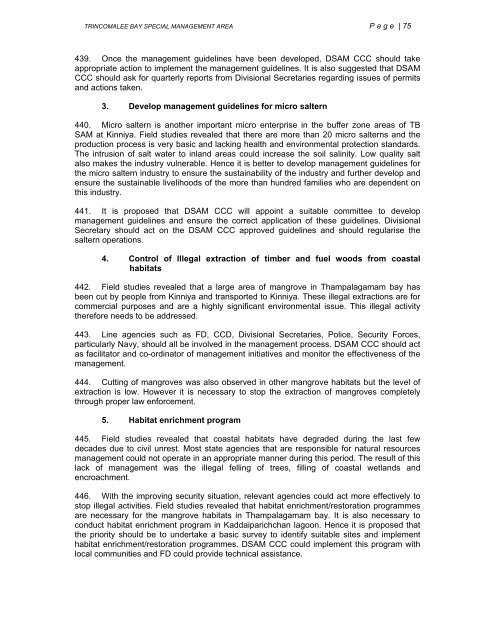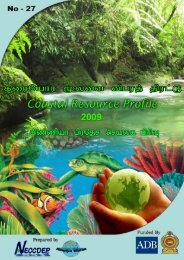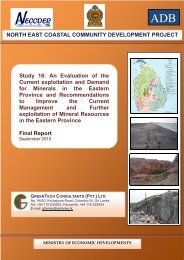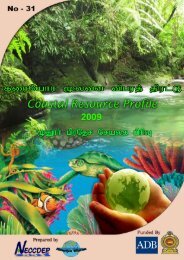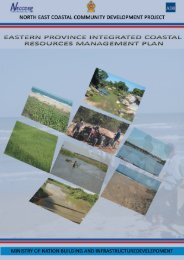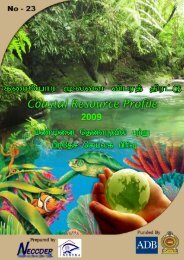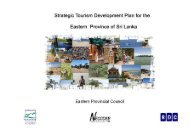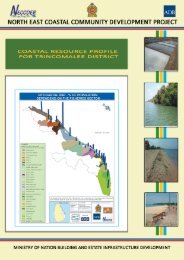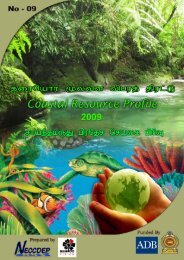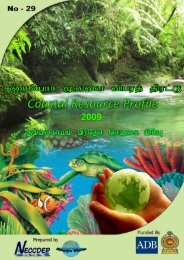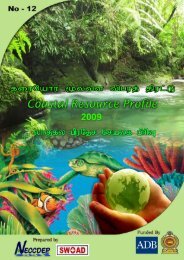Untitled - Neccdep.com
Untitled - Neccdep.com
Untitled - Neccdep.com
Create successful ePaper yourself
Turn your PDF publications into a flip-book with our unique Google optimized e-Paper software.
TRINCOMALEE BAY SPECIAL MANAGEMENT AREA Page | 75<br />
439. Once the management guidelines have been developed, DSAM CCC should take<br />
appropriate action to implement the management guidelines. It is also suggested that DSAM<br />
CCC should ask for quarterly reports from Divisional Secretaries regarding issues of permits<br />
and actions taken.<br />
3. Develop management guidelines for micro saltern<br />
440. Micro saltern is another important micro enterprise in the buffer zone areas of TB<br />
SAM at Kinniya. Field studies revealed that there are more than 20 micro salterns and the<br />
production process is very basic and lacking health and environmental protection standards.<br />
The intrusion of salt water to inland areas could increase the soil salinity. Low quality salt<br />
also makes the industry vulnerable. Hence it is better to develop management guidelines for<br />
the micro saltern industry to ensure the sustainability of the industry and further develop and<br />
ensure the sustainable livelihoods of the more than hundred families who are dependent on<br />
this industry.<br />
441. It is proposed that DSAM CCC will appoint a suitable <strong>com</strong>mittee to develop<br />
management guidelines and ensure the correct application of these guidelines. Divisional<br />
Secretary should act on the DSAM CCC approved guidelines and should regularise the<br />
saltern operations.<br />
4. Control of Illegal extraction of timber and fuel woods from coastal<br />
habitats<br />
442. Field studies revealed that a large area of mangrove in Thampalagamam bay has<br />
been cut by people from Kinniya and transported to Kinniya. These illegal extractions are for<br />
<strong>com</strong>mercial purposes and are a highly significant environmental issue. This illegal activity<br />
therefore needs to be addressed.<br />
443. Line agencies such as FD, CCD, Divisional Secretaries, Police, Security Forces,<br />
particularly Navy, should all be involved in the management process. DSAM CCC should act<br />
as facilitator and co-ordinator of management initiatives and monitor the effectiveness of the<br />
management.<br />
444. Cutting of mangroves was also observed in other mangrove habitats but the level of<br />
extraction is low. However it is necessary to stop the extraction of mangroves <strong>com</strong>pletely<br />
through proper law enforcement.<br />
5. Habitat enrichment program<br />
445. Field studies revealed that coastal habitats have degraded during the last few<br />
decades due to civil unrest. Most state agencies that are responsible for natural resources<br />
management could not operate in an appropriate manner during this period. The result of this<br />
lack of management was the illegal felling of trees, filling of coastal wetlands and<br />
encroachment.<br />
446. With the improving security situation, relevant agencies could act more effectively to<br />
stop illegal activities. Field studies revealed that habitat enrichment/restoration programmes<br />
are necessary for the mangrove habitats in Thampalagamam bay. It is also necessary to<br />
conduct habitat enrichment program in Kaddaiparichchan lagoon. Hence it is proposed that<br />
the priority should be to undertake a basic survey to identify suitable sites and implement<br />
habitat enrichment/restoration programmes. DSAM CCC could implement this program with<br />
local <strong>com</strong>munities and FD could provide technical assistance.


